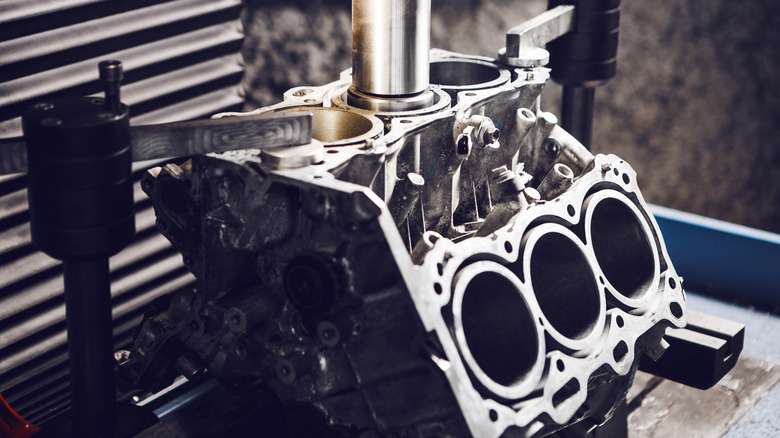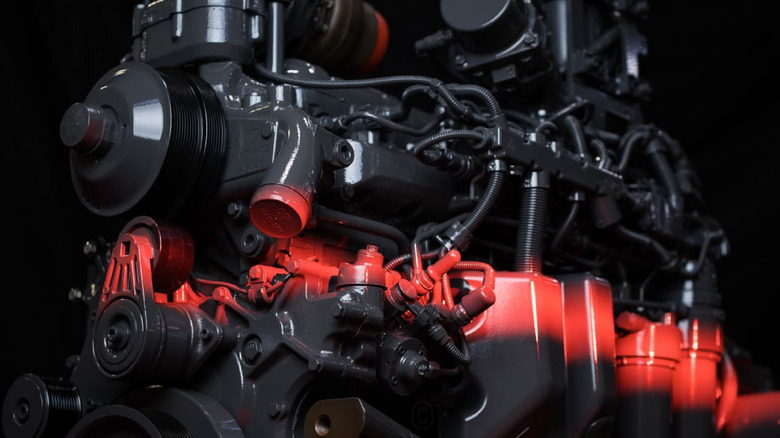Why Don't Seven-Cylinder Car Engines Exist?
It's one of those questions you've probably never thought to ask, but the second you hear it, it's stuck in your head. Automakers have produced cars with three, four, five, six, eight, 10, 12, and 16 cylinders, but what about lucky number 7? The truth is, seven-cylinder engines are very much a real thing, although you won't find one under the hood of any production car. Seven-cylinder engines aren't used in cars for one main reason — balance.
An engine is a place of violent activity with pistons firing, a fast-rotating metal crankshaft, and pumps circulating oil and coolant to keep things running. All this motion generates a ton of vibration, which is where engine balancing comes in. This part of the engineering and manufacturing process ensures that for every bit of off-axis force exerted on an engine, there's a corresponding force canceling it out. It's far easier to balance an inline engine with an even number of cylinders than one with an odd cylinder count, and V-format engines can be balanced across the two cylinder banks. The bottom line is that building an inline-seven car engine would introduce a level of complexity and awkwardness that manufacturers have decided is just not worth the effort.
Lessons from 3-cylinder and 5-cylinder engines
To better understand why the seven-cylinder is a no-go, it helps to look at existing engines with an odd number of cylinders. The three-cylinder engine, for example, is often described as a straight-six engine cut in half. This configuration reveals an inherent problem as there will be moments during the engine's rotation when none of the pistons are in the right position for compression, combustion, or power delivery. The still-moving dead weight of the asymmetrical crankshshaft then makes the engine want to rock and twist as it runs. To handle this, engineers install a counter-rotating balance shaft, which adds complexity and weight to the engine. Five-cylinder engines experience a similar imbalance, although the extra two cylinders add mass and make the problem worse.
This issue with counterbalancing is one of the reasons automakers don't build many five-cylinder engines, although you can find inline-fives in some Volvo, Audi, Fiat, and Land Rover models. Engineers also must consider a phenomenon called firing overlap. A typical three-cylinder engine has no cylinders firing during 60 of its 360 degrees of rotation, which leads to lots of rocking and vibration. A five-cylinder, however, has more combustion events packed into each turn of the crankshaft.This results in a 36-degree arc where power strokes merge, smoothing things out considerably.
It's natural to wonder if adding two more cylinders would increase overlap even further, but there are other engineering obstacles to putting inline-seven engines in cars. Adding two cylinders means making a cranskhaft that is stiff and heavy enough to resist flexing during rotation, which is expensive and inefficient. There's also a challenge in trying to fit such a long motor into existing chassis designs. Simply put, a seven-cylinder simply magnifies the problems of odd-cylinder engines to where any engineering solutions become too cumbersome for a passenger car. It's proved far easier for most auto manufacturers to build V-format engines.
Seven-cylinder engines are better suited to industrial use
Seven-cylinder engines do exist, but they're limited to heavy industrial uses like for farm equipment and large boat engines. For instance, a company called AGCO Power makes a 9.8-liter inline-seven diesel engine for tractors and combine harvesters. This beast is made to run at low speeds, but can produce over 489 horsepower and more than 1,400 foot-pounds of torque. A key factor is that these industrial engines run at a steady and relatively low revolutions per minute (rpm).
This makes balancing far easier for engineers, as they don't have to account for the sudden acceleration and deceleration that a car engine goes through. Older aircraft also frequently used radial engines with odd cylinder counts like five, seven, or nine. In that format the cylinders are arranged in a circle, allowing a single large counterweight to keep the entire assembly balanced as the engine runs. There are plenty of disadvantages to radial engines that make that format impractical for cars, though.


